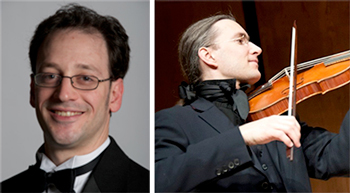by Daniel Hathaway & Mike Telin

Brault is well-known to area audiences as the concertmaster for Cleveland’s baroque orchestra, Apollo’s Fire, a position the Montréal-based violinist has held for the last four seasons while continuing to appear with such Canadian ensembles as Les Boréades de Montréal, Ensemble Caprice and La Bande Montréal as well as his own group, Sonate 1704.
He was appointed to Apollo’s Fire when artistic director Jeannette Sorrell felt the need to bring more continuity to the leadership of the orchestra’s strings after a period when the concertmaster’s duties had been shared around among several players. “She asked her former concertmaster, David Greenberg, who is from Montréal, for a recommendation,” Brault told us in a phone conversation from his home in Terrebonne, Québec. “I auditioned for her while she was in Montréal visiting friends. She offered me a concert four years ago and it went so well and we had so much fun and the communication was so great that she offered me the position.”
Sorrell was also instrumental in bringing Olivier Brault to the attention of Christopher Wilkins and the Akron Sympony. “Jeannette was hired to conduct a concert that included the first and fifth Brandenburg Concertos and she asked to bring me along as violin soloist,” Brault said. “I was overwhelmed by questions from the players — the first cellist asked me for a lesson — and there was a nice energy. Christopher Wilkins visited me in my dressing room and invited me to solo in Vivaldi’s Four Seasons.”
Olivier Brault discovered the period instrument movement when he was in high school. “My elder sister bought me Nikolaus Harnoncourt’s book, Music as Speech, which opened my eyes dramatically. Then when I was 15 or 16, I bought myself a birthday present: Musica Antiqua Köln’s recording of the Art of Fugue. I was fascinated by the sound of the instruments.” When Brault entered the Montréal Conservatory, he discovered a treatise by Pierre Baillot “from 1835, the middle of the Romantic period, that talked about playing without vibrato, with gut strings and scordatura, that made me realize that post-1800 violin playing was much closer to baroque music than we thought. I was struck by lightning!”
Like any passionate, 17-year-old convert, Brault “went crazy.” He ditched his chin rest, restrung his fiddle with gut and went forth to play the Brahms fourth symphony with the conservatory orchestra. “They kicked me out!” he said, but he was able to enroll at another branch of Québec’s interconnected conservatory system and went back to the beginning with an inspiring new mentor who told him to learn the violin first and then he could do anything he wanted. Brault took his bachelor’s and master’s degrees there, then after six years of playing in various ensembles, completed his doctorate in 2007 on the topic of 18th century French violin sonatas, a project that took him to France and resulted in the founding of Sonata 1704, named after the publication date of the first-ever book of French sonatas.
For his appearance with the Akron Symphony in a piece he has played many times, Olivier Brault has decided to tune his baroque instrument up to A=440, “Vivaldi’s pitch at the Ospedale della Pietà in Venice. My violin is a Venetian model made in Montréal in 1998 — it has a beautiful sound and is very powerful. I’ll play as loud as possible with gut strings and a baroque bow. I think it’s more fun for the audience to hear a baroque violin than to hear a baroque player using a modern violin. And of course, I feel much more comfortable!”
In addition to his position as principal bassoon of the Akron Symphony, Todd Jelen is principal with the Canton Symphony, and the Wheeling Symphony in West Virginia.
Jelen played the Mozart concerto, written when the composer was 18, for his second graduate recital at the Cleveland Institute of Music. “It was really fun,” he recalled in a recent phone conversation, “but I’m looking forward to playing the entire work again. I think I have a fresh perspective on the piece. The interplay with the orchestra is something you don’t get in the practice room or even playing it with piano. It’s really great writing and I’m especially looking forward to the second movement, which has a theme Mozart used later in The Marriage of Figaro.”
“Although there are many good concertos written for the bassoon, Mozart’s encompasses all of the great, idiomatic things the bassoon can do,” Jelen noted, undoubtably the reason that the first movement of the work is included in most symphony orchestra audition lists. On Saturday, Jelen will put his own stamp on the piece by performing his own cadenzas. “I’ve revised them from my grad school performances, and I’ve tried to stay in the style of Mozart.”
As a young student, Todd Jelen was first lured in the direction of playing the bassoon when he saw a picture of the instrument. “I thought it looked interesting. I played saxophone for a year then I had the chance to play the bassoon in Junior High band. They gave me an instrument and a book and told me to go practice!”
Though Jelen won’t be using an instrument from Mozart’s period for the concerto, his bassoon carries its own pedigree. He plays a Heckel instrument made in Germany in 1930, serial number 7118 in the firm’s famous 7000 series. “All three bassoons that I’ve owned have had serial numbers ending in ‘8’”, he noted. “Doubly weird is that this was originally a military band instrument so it has a second, Marine Corps stamp: ‘No. 108.'”
Published on ClevelandClassical.com January 7, 2014
Click here for a printable version of this article.



